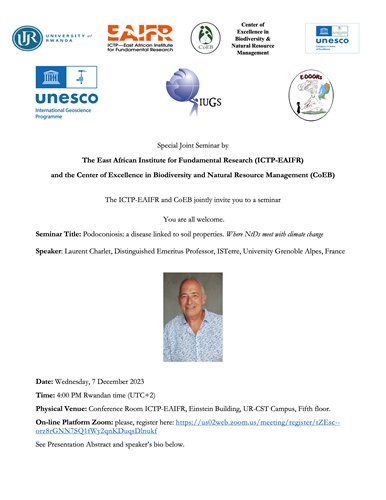ICTP-East African Institute for Fundamental Research
KIST2 Building CST
Nyarugenge Campus
University of Rwanda
Kigali, Rwanda
Joint ICTP-EAIFR and CoEB Hybrid seminar
Professor Laurent Charlet, Distinguished Emeritus Professor, ISTerre, University Grenoble Alpes, France, will discuss Podoconiosis: a disease linked to soil properties.
Special Joint Seminar by
The East African Institute for Fundamental Research (ICTP-EAIFR)
and the Center of Excellence in Biodiversity and Natural Resource Management (CoEB)
The ICTP-EAIFR and CoEB jointly invite you to a seminar
You are all welcome.
Seminar Title: Podoconiosis: a disease linked to soil properties. Where NtDs meet with climate change
Speaker: Laurent Charlet, Distinguished Emeritus Professor, ISTerre, University Grenoble Alpes, France
Date: Wednesday, 7 December 2023
Time: 4:00 PM Rwandan time (UTC+2)
Physical Venue: Conference Room ICTP-EAIFR, Einstein Building, UR-CST Campus, Fifth floor.
On-line Platform Zoom: please, register here.
Abstract
Non-communicable disease among the poor in Rwanda has a very different face than that seen in middle- or high-income populations. While Rwanda has enjoyed rapid economic growth and political stability in recent years, most of the population survives on subsistence agriculture. Bare foot farmers suffer from Podoconiosis, a non-transmissible Elephantiasis type of neglected tropical disease (NTD) according to WHO; In Rwanda its severity compares to other prevalent diseases such as asthma, as assessed by its disability-adjusted life year DALY (000’s) value of 47.6, with higher risk among women and genetically susceptible individuals. Podoconiosis is a lymphoedemia, of the lymph vessels leading to feet and legs swelling. It is caused by chronic exposure during early childhood to high-altitude irritant volcanic soils. Since beginning in the 1960s, massive migration of mainly cultivators replaced in the affected areas the indigenous hunter-gathering tribe. Subsequently, land use pattern changed drastically, from forest dominated to subsistence agriculture on volcanic soils were cultivated. While the period of mass cultivation coincides with the appearance of the disease in the area, climate change may exacerbate it through loss of soil organic matter and thus bioavailable soil irritant mineral particles, which penetrate the skin of the foot, migrate into lymphatic vessels where they are taken up by macrophages and induce inflammation with subsequent fibrosis.
Podoconiosis etiology was first described in the 1970s by Dr. Ernest W. Price, a British surgeon living in Ethiopia, working in a leprosarium. Studying with electron microscopy the lymph nodes and vessels of patients affected by the disease, he showed the presence of silicon, aluminum both in the phagosomes of macrophages and adherent to the surface of lymphocytes, a finding we recently confirmed (and extended, e.g. to titanium) by advanced LIBS spectro-microscopic measurements. Bare foot farming occurs throughout the tropics without known occurrence of such a disease, and thus minerals typical of lateritic soils such as kaolinite or iron and aluminum oxides are poor candidates for such an uptake. Among minerals naturally present in volcanic soils, (such as allophane, halloysite), only one has the asbestos-like morphology that could favor such a skin uptake: Imogolite, with its 1 nm wide nanotubes morphology. We will discuss the conditions leading to such an irritant mineral, by discussing volcanic soil (andosol) pedogenesis, physical-chemical, but also microbial, processes leading to their growth on pumice, and possibly volcanic ashes. We will also discuss some microbial co-infection, recently demonstrated by a Cameroon-Germany team, as well as some specific imogolite properties (e.g. hydrophobicity) which could lead to this uptake. Finally, we will compare skin potential exposure to natural nanotubes (imogolite) with that to modern nanotechnology, nanowires, good candidates for future touch-screens.
Biography
Laurent Charlet is Distinguished Emeritus Professor in Bio-nano-geochemistry at ISTerre, University Grenoble Alpes (UGA), France. Laurent earned an Engineering Agronomy degree in France, and a Ph.D. in Soil and Environmental Sciences at the University of California, USA, followed by two postdocs in Switzerland (EAWAG and Uni Bern). He created the Environmental Geochemistry team at ISTerre and brought it into the global spotlight by performing research at drastically different scales: (i) large scale multidisciplinary field investigations (on the “Medical Geology” fate of geogenic toxics such as mercury in Amazonian forest fishes, arsenic in SE Asian delta drinking water, soil volcanic particles and Podoconiosis) and (ii) molecular level investigations at synchrotron facilities (µXAFS), ESR and Mössbauer, with a special focus on toxicology related to redox chemical phenomena of importance to Human Health, as a basis towards a geochemical basis to Public Health politics and policies. He is holder of the CNRS Silver Medal for Excellence in Research, an Honorary chair at the University of Swansea (UK), Honorary member of the Institut Universitaire de France, and 10 year-long International Research advisor to UGA Chancellor. He is presently Affiliate to LBNL, Berkeley (USA) and Adjunct Professor at the University of Waterloo (Canada) and Central Michigan University (USA), and has been visiting professor at UC-Berkeley (US), EPFL-Lausanne (Switzerland), and Uni. Utrecht (The Netherlands). His research has been published in 283 primary research publications, cumulating above 11,000 citations and corresponding to a h-index of 77 (ORCID number is: 0000-0003-3669-7316).




